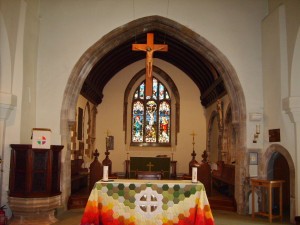
A Historical Guide to St Michael and All Angels Church.
Introduction
This is an excerpt from the guide which was produced during the months up to September 2002. It was researched from archives and record offices both within Sussex and further afield by Doreen Parish. The full guide is available in printed form from St Michael’s Church.
SAXON TIMES
There has been a church on this site since Saxon times and St. Michael and All Angels is one of the few continuously used churches from that time in the area. Tradition says that the present church is the fourth church on the site. The first church was most probably built of wood. That was superseded by three others; possibly a Saxon stone church; an updating by the Normans of this church (whose nave was destroyed by fire in 1830, leaving the chancel and tower intact) and the 19th century rebuild of the nave. The reality is that the church which is the St. Michael’s of today is a building that has grown and changed over the years. What is certain is that for 1100 years or more there has been a distinctive Christian witness on this site.
However, it has not always been known as St. Michael’s. Until the 18th century the dedication was to St. Margaret (of Antioch?). Evidence of this is a will dated 1520, where one, Richard Inskippe of Chichester, left the sum of 12d to the ‘Cimeterio Sancte Margarita de Southwyke’.
THE TOWER
The tour starts at the West door of the tower, which is not as old as it may seem. On February 21st 1941 the tower was badly damaged by an unexploded bomb. The Bomb Disposal Unit dug a deep hole but could not find the bomb. A second hole was dug but still the bomb was not found, although its track was detected. As the tower was now dangerous due to the impact of the bomb and subsequent digging, the Bomb Disposal Unit refused to explore further until the tower had been demolished.
After consultation with the Ancient Monuments Department of The Ministry of Defence as to the best plan of action, it was decided to carefully take the tower down to ground level, mark each stone and timber section, record them on a plan and store them in the churchyard for rebuilding. This done, the Bomb Disposal Unit started a third excavation and found a one-ton bomb near the West end of the North aisle on New Years Day 1943. The bomb had remained embedded in the churchyard for nearly two years. It was defused and was, for some time, exhibited in the church.
The tower was meticulously reconstructed by Frank Duke, builders, of Steyning, the cost being borne by the War Damage Commission. It was decided to build vestries on each side, the tower proper providing an entrance vestibule. The original tower did not have an external door, but this was provided and is an extremely accurate copy of a Norman doorway. The wrought iron on the door incorporates the date, 1950 and was made by George Allen of Hurstpierpoint. There was difficulty in rebuilding, as underground streams had to be pumped out day and night. The tower is now supported on concrete piles driven 40 feet into the chalk.
The wooden spire was reconstructed using the old timbers, with the addition of some new shingles.After the tower had been completed, a green line could be seen running down from the top to the bottom of the stone quoins at the Southwest corner. Reconstruction had been so accurate that the original staining from the old lightning conductor was in exactly the same position as before the demolition.
Until the tower was taken down it was believed that the tower had been a Saxon squat tower with additions. The demolition proved that the middle section formed an integral part of the whole. The tower is in three stages:- the lower one with 11th century windows, very similar to those of churches of Old and New Shoreham and the upper storey is early 13th century with circular sound holes, also similar to those in the Shoreham churches, suggesting the work of the same builders.








 Church Magazine
Church Magazine